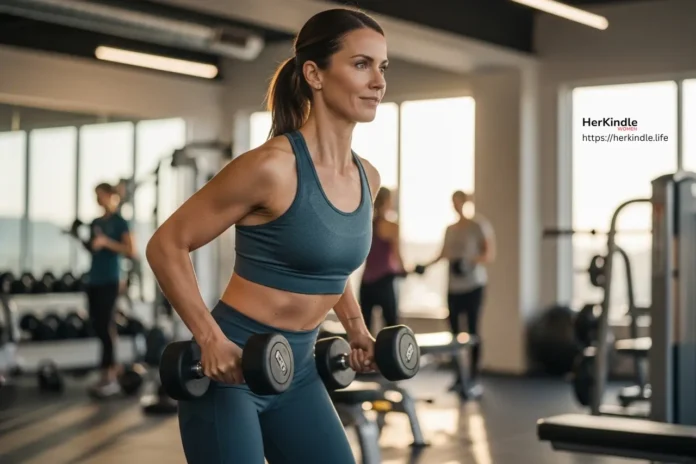Strength training is no longer a fitness niche reserved for athletes or young men. For women—especially those over 35—it is a scientifically proven way to transform physical health, hormonal balance, and mental well-being. From women’s strength training benefits like bone density improvement and metabolic health, to debunking strength training myths for women that keep many from lifting, this guide covers everything you need to start and thrive in your fitness journey.
We will explore the physiological, emotional, and practical reasons why strength training for women is essential, provide guidance on the best strength training exercises for women, share sample women’s strength training programs, and highlight recovery and nutrition strategies tailored for women in midlife and beyond.
Why Strength Training Is Crucial for Women Over 35
1. Hormonal Health and Metabolism
With age, women experience shifts in estrogen and progesterone levels, which can lead to reduced muscle mass and slower metabolism. Incorporating strength training combats these changes by preserving lean muscle, improving insulin sensitivity, and boosting metabolic rate. Research highlights that two to three weekly resistance sessions significantly improve body composition and energy expenditure, helping women manage midlife weight fluctuations without extreme dieting.
2. Bone Health and Osteoporosis Prevention
After menopause, bone density declines, raising the risk of osteoporosis and fractures. Strength training for women stimulates bone remodeling, particularly in critical areas like the spine and hips. Studies show it reduces fracture risk by up to 40%, making it one of the most effective non-pharmaceutical interventions for osteoporosis prevention.
3. Functional Independence and Daily Strength
The ability to carry groceries, climb stairs, or lift grandchildren comfortably is directly linked to strength. Strength training improves balance, joint protection, and overall mobility. Women who lift are less likely to experience falls, injuries, or age-related frailty, allowing them to maintain independence and an active lifestyle longer.
Best Strength Training Exercises for Women
Strength training does not require fancy equipment or hours in the gym. A combination of bodyweight exercises and progressive resistance training is ideal for women of all fitness levels. These best strength training exercises for women target major muscle groups and build functional strength.
Lower Body
- Squats: Builds strength in quads, hamstrings, glutes, and core. Use bodyweight or add dumbbells/barbells as you progress.
- Deadlifts: Strengthens hamstrings, glutes, back, and grip—critical for functional strength.
- Lunges: Enhances single-leg balance and hip mobility, reducing fall risk.
- Glute Bridges/Hip Thrusts: Improves glute strength and pelvic stability.
Upper Body
- Push-Ups: Develops chest, shoulders, and arms; can be modified to knees or incline versions for beginners.
- Chest Press: Builds pressing strength and supports bone health in upper extremities.
- Rows (Dumbbell or Cable): Improves posture and back strength, countering desk-related rounding.
- Overhead Press: Strengthens shoulders and upper back while improving core stability.
Core
- Planks: Builds core endurance essential for spinal stability.
- Russian Twists: Targets oblique muscles for trunk rotation control.
- Dead Bugs: Great for safe, functional abdominal activation.
For those starting at home, resistance bands or simple dumbbells are enough to begin building strength safely.
Women’s Strength Training Programs
Creating an effective women’s strength training program involves progressive overload, balanced recovery, and flexibility for life’s demands. Here are three sample programs based on fitness level.
Beginner (Weeks 1–4)
Frequency: 2–3 sessions/week
Sample Routine:
- Squats – 3 sets of 10–12 reps
- Push-Ups (modified if needed) – 3 sets of 8–10 reps
- Rows – 3 sets of 10 reps
- Glute Bridge – 3 sets of 12 reps
- Plank – 3 rounds, 30–45 seconds hold
Goal: Focus on form, consistency, and confidence with foundational movements.
Intermediate (Weeks 5–12)
Frequency: 3–4 sessions/week (Upper/Lower Split)
Sample Routine:
- Barbell Deadlift – 4 sets of 6–8 reps
- Bench Press – 4 sets of 8–10 reps
- Lunges – 3 sets of 10 each leg
- Overhead Press – 3 sets of 10 reps
- Russian Twists – 3 sets of 20 reps
Advanced (Ongoing)
Frequency: 4–5 sessions/week with a mix of hypertrophy and strength blocks. Includes power lifts and accessory movements for symmetry and performance. A sample split:
- Day 1: Lower (Quads Focus)
- Day 2: Upper (Push Focus)
- Day 3: Lower (Hamstrings & Glutes Focus)
- Day 4: Upper (Pull Focus)
- Day 5: Conditioning & Core
Debunking Strength Training Myths for Women
Myth 1: “Strength Training Will Make Women Bulky”
Women naturally produce lower testosterone than men, making extreme muscle hypertrophy unlikely without specialized diets or performance-enhancing substances. Regular strength training instead creates lean muscle, improved muscle tone, and higher metabolic rate—not bulky physiques.
Myth 2: “Cardio Alone Is Enough”
While cardio is essential for cardiovascular health, it does not maintain muscle mass or bone density the way resistance training does. Combining cardio and strength training produces the best results for weight management and healthy aging.
Myth 3: “Older Women Should Avoid Lifting”
Research consistently shows women well into their 60s and beyond can safely lift weights with proper guidance. Strength training is one of the best tools for reducing fall risk and maintaining functional independence.
Nutrition and Recovery Strategies
Strength gains rely on effective recovery and proper nutrition. These strategies are especially relevant for women balancing hormonal changes, work, and family responsibilities.
1. Protein Intake
Consume 0.7–1 gram of protein per pound of body weight daily to support muscle repair and growth. Lean meats, eggs, dairy, legumes, and plant-based protein powders are excellent sources.
2. Sleep and Stress Management
Aim for 7–9 hours of quality sleep per night. Sleep supports hormonal regulation and faster recovery. Practices like meditation and breathwork lower cortisol, which otherwise impedes muscle growth and fat loss.
3. Active Recovery
Yoga, Pilates, or low-intensity walking on rest days improves circulation, reduces soreness, and supports joint mobility.
Mental Health and Emotional Benefits
Strength training builds more than muscle—it strengthens confidence and emotional resilience. Studies show women who strength train experience reduced anxiety and depression, improved self-image, and greater life satisfaction. The physical act of lifting often mirrors personal empowerment: overcoming resistance, building resilience, and seeing tangible progress over time.
FAQs
Yes, and you should. Women of all ages see significant strength, mobility, and metabolic improvements.
Strength training boosts metabolism and preserves muscle while reducing fat mass, including abdominal fat, when paired with proper nutrition.
Improvements in strength and energy can appear within 4–6 weeks, with visible muscle tone often following within 8–12 weeks.
Conclusion
Strength training for women is one of the most impactful lifestyle changes you can make after 35. It supports bone health, preserves independence, improves mood, and reshapes your body safely and sustainably. Start today with just two sessions per week, focus on proper form, and increase intensity gradually.
Ready to take action? Build your first workout plan from our beginner guide above and experience firsthand how empowering strength training can be.







